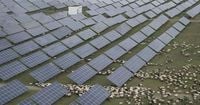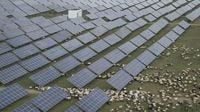High on the windswept Tibetan plateau, where the sun blazes across a vast, sparsely populated landscape, China is taking a bold leap in its race toward a greener future. On August 20, 2025, Chinese government officials announced plans to build what they claim will be the world’s largest solar farm, a project that could reshape not only the country’s energy landscape but also the global fight against climate change.
Spanning an astonishing 610 square kilometers—roughly the size of Chicago—this solar farm will be adorned with over 7 million panels and is designed to generate enough electricity to power approximately 5 million households. As reported by Devdiscourse and other outlets, the scale of this project is unlike anything the world has seen before, reflecting China’s fierce commitment to leading the transition to renewable energy sources.
According to a recent study cited by both BBC and Devdiscourse, China’s aggressive push into renewables is already bearing fruit. For the first half of 2025, the country saw a 1% drop in carbon emissions compared to the same period in 2024, continuing a trend that began in March 2024. This decline, while modest, is significant for a nation that has long been the world’s largest emitter of greenhouse gases. The development has sparked speculation among analysts that China’s carbon emissions may have peaked earlier than the government’s official target of before 2030.
“This is the first indication of a structural decline in emissions,” said Lauri Myllyvirta, an analyst at the Centre for Research on Energy and Clean Air, as reported by BBC. “It’s a pivotal moment.” Myllyvirta and other experts argue that these numbers could signal a transformative shift in the country’s emissions trajectory, provided the trend continues and is not reversed by future economic or policy changes.
But reaching China’s ambitious climate goals will require more than just one record-breaking solar farm. The government has pledged to achieve carbon neutrality by 2060, a target that will demand an average reduction in emissions of 3% per year for the next 35 years. That’s a tall order for any country, especially one with China’s massive industrial base and growing energy needs.
The challenge is made even steeper by surging electricity demand. In the first half of 2025 alone, demand grew by 3.7%. Yet, in a promising twist, the increase in power generated from solar, wind, and nuclear sources actually outpaced this demand. This suggests that renewables are not just keeping up—they’re starting to pull ahead. It’s a scenario that, as Li Shuo of the Asia Society Policy Institute told BBC, “demonstrates the potential for economic growth alongside emissions reductions.”
Still, there’s no denying the elephant in the room: coal. Despite the impressive strides in renewables, China remains heavily reliant on coal-fired power plants, which currently form the backbone of its electricity grid. Li Shuo cautioned that “the heavy reliance on coal remains a serious obstacle,” emphasizing the urgent need for the economy to shift toward less resource-intensive sectors.
Integrating variable sources like wind and solar into a grid built for the steady output of coal plants is no simple feat. The rigidity of China’s electricity grid complicates efforts to balance supply and demand, especially as more intermittent renewables come online. “Policymakers are aware of the necessary changes,” Myllyvirta observed, “but implementing them is a complex challenge requiring significant adjustments to grid management and operations.”
To address these hurdles, China is investing in a vast network of transmission lines designed to move green energy from the remote Tibetan plateau to the bustling industrial centers of the east. Ongoing projects already connect Qinghai Province to Henan, and there are plans for further lines reaching all the way to Guangdong Province. These massive infrastructure efforts are essential to ensure that the clean power produced in sparsely populated regions doesn’t go to waste, but instead helps fuel the country’s economic engine.
Experts like those cited by Devdiscourse stress the importance of strategic grid management and the expansion of transmission lines. Without these, the full benefits of renewable energy investments could be squandered. “It’s not enough to generate green power,” one analyst noted. “You have to get it to where it’s needed.”
The Tibetan solar farm, with its sea of panels shimmering under the high-altitude sun, stands as a symbol of both China’s progress and its ongoing challenges. On one hand, it highlights the nation’s capacity for technological innovation and large-scale project execution. On the other, it underscores the complexities of transitioning from a coal-dependent economy to one powered by clean energy.
The stakes are high—not just for China, but for the entire planet. As the world’s most populous country and its largest emitter, China’s energy choices will have ripple effects far beyond its borders. If the country can maintain and accelerate its current momentum, it could serve as a blueprint for other developing nations grappling with the twin demands of economic growth and environmental responsibility.
Yet, as both Li Shuo and Lauri Myllyvirta caution, the road ahead is anything but straightforward. Achieving a sustained annual reduction in emissions, over three decades, will require not just technological upgrades and new infrastructure, but also deep changes in how China’s economy is structured and how its energy system is managed. The transition from coal to renewables is fraught with logistical, economic, and political challenges.
For now, the world’s eyes are on the Tibetan plateau, where millions of solar panels are poised to catch the sun’s rays and, perhaps, light the way to a new era. The success of this project could mark a turning point—not only for China’s emissions, but for global efforts to avert the worst impacts of climate change.
As the sun rises over the plateau, it brings with it both hope and a reminder: the path to a sustainable future is long, but every step counts.


